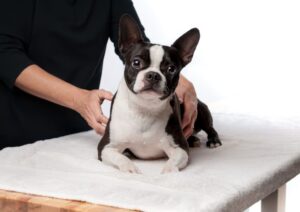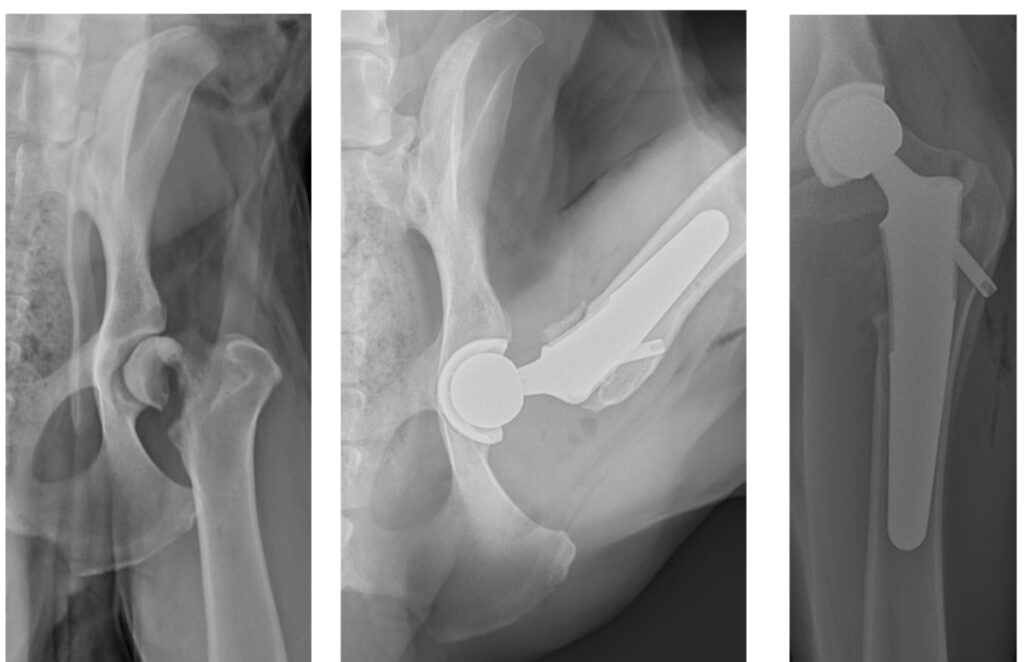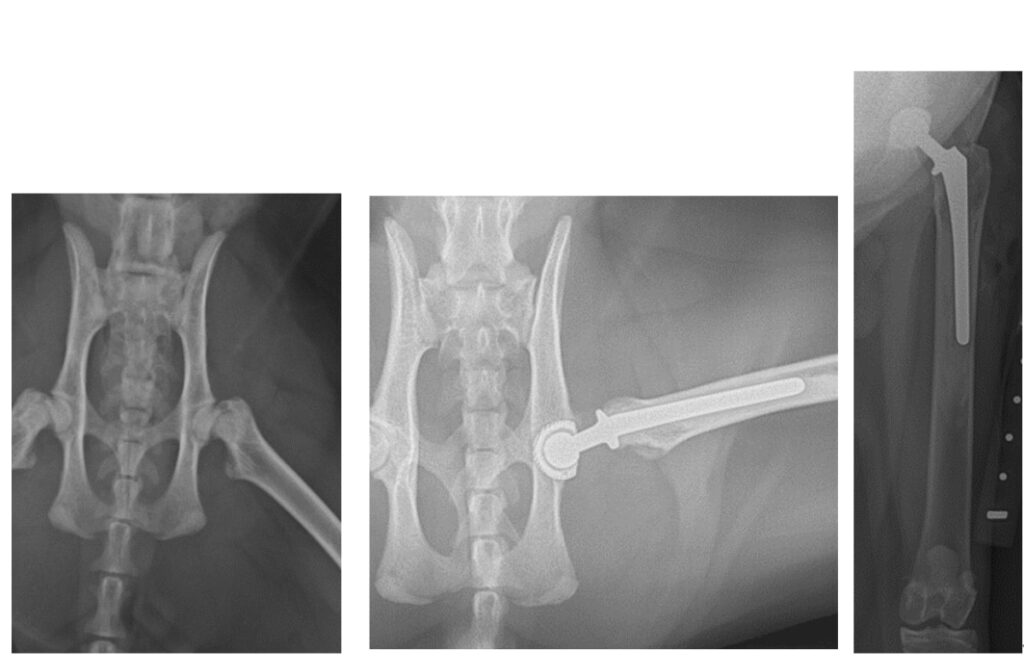

寵物新知
假如我的動物被轉介進行全髖關節置換評估,作為主人有什麼需要了解清楚?
全髖關節置換術(THR)是針對那些傳統治療無法完全緩解不適及發育不良動物進行的。全髖關節置換術是一種挽救性手術,即在其他治療無效的情況下作為最後手段進行。
患有嚴重骨關節炎或髖關節發育不良的狗隻,在某些情況下,可以從髖關節置換中受益。全髖關節置換術是一種進階的外科手術,應由經驗豐富的骨科外科醫生進行。
然而,THR仍然是治療犬髖關節發育不良最有效的外科手術。外科醫生用合金(鈦/鈮/鈷/鉻)和陶瓷、熱塑性塑料(PEEK)或聚乙烯(交聯UHMWPE)製成的植入物替換整個關節。這種手術比TPO提供更好的結果。如果執行得當,它可以完全恢復整體的功能,並消除與發育不良髖關節的關節炎變化相關的骨關節炎疼痛。這個修復應該能夠維持犬隻整個壽命。
全髖關節置換術後的仔細康復至關重要。術後患者應在手術後的前6週內進行嚴格管理。物理治療可以在術後第十天開始。在大多數情況下,建議在手術後的前12週內進行牽引步行。
目前,有許多THR系統;BioMedtrix、Kyon、Vetmaster、Bluesao、Innovet、Helica、Dingo或在一些專科中心,他們為每個案例定制組件。
我們使用BioMedtrix系統進行全髖關節置換,因為它是文獻記錄最廣泛的系統,具有強有力的文獻支持其有效性和安全性。我們的外科醫生也在該系統上積累了豐富的經驗和專業知識,確保為我們的患者提供最高水平的護理。
諮詢
在手術之前,醫生通常會對您的寵物進行全面的評估。動物經常會出現髖關節骨關節炎並同時伴有其他併發症,例如腰骶疾病、膝關節疾病、多發性關節炎等。同時我們還要通過病史和骨科檢查評估,確保沒有其他比全髖關節置換術更為合適的替代治療方案(請參閱文件《何時應考慮為患關節炎的狗或貓進行全髖關節置換術》)。
在詳細討論全髖關節置換術的風險和益處之後,如果您選擇為您的寵物進行全髖關節置換術,我們將安排您的寵物在鎮靜/全身麻醉下進行電腦掃描(CT)或X光片檢查,以便進行術前規劃並確保選擇最佳的植入物的尺寸。如果不是緊急的,手術通常會安排在幾週後進行。
術前準備
接受全髖關節置換的動物會在手術當日一早入院。牠們術前必須禁食。主人在手術前的晚上給動物進食最後一餐,但手術當天早上不要再餵食早餐,切記過夜不需要禁飲水。
手術前,您的寵物將接受檢查,以排除任何皮膚或耳朵感染的跡象。手術前幾小時剃毛會增加術後感染的風險。為了降低這種風險,您的寵物只有在麻醉後才會被剃毛。這意味著有時在動物被麻醉剃毛後才會發現皮膚感染的跡象。若有任何感染跡象,手術必須推遲到這些感染(通過使用洗髮水和抗生素)徹底消除後才可進行,以便減少髖關節植入物感染的風險。
手術簡介
全髖關節置換術是用人工杯和球替換髖關節的“球窩”組件。我們使用 BioMedtrix 髖關節置換系統,該系統由模塊化的骨水泥固定系統和無骨水泥固定系統組成。這個系統可能是獸醫骨科專家最常使用的系統之一,也是目前在詳細文獻記載中有充分病案證實最可靠的系統之一。此外,使用該系統的外科醫生必須獲得專門認證,以確保他們有資格進行此項手術。
可以使用兩種植入物和固定方式,有或無骨水泥。無骨水泥髖關節植入物是“壓配式”的,骨頭會長入植入物表面的孔隙中。這具有一旦骨頭完全長入植入物後即可實現長期穩定的優點。使用骨水泥固定的植入物則是通過骨水泥固定。它們通常在早期週更穩定,但可能與長期無菌鬆動的低風險相關。
選擇使用骨水泥固定系統或無骨水泥固定系統是一個相當複雜的過程,要視個別病患的情況而定。
麻醉須知
全身麻醉由麻醉專科醫生負責實施,以確保麻醉過程最安全以及圍手術期使用最佳的鎮痛方案。
住院須知
住院時間長短根據病患的術後恢復進度和鎮痛效果而定,通常在手術後的第二日病患就能使用患肢站立。如進度理想,通常留院觀察一至兩日就可以出院。
術後恢復
步行 術後您的愛犬應該在短牽引繩下才可進行每次最多五分鐘的步行,每日三到四次且僅限於如厠,如厠完畢後應立即返回籠子或圍欄。在癒合過程中,您的動物應該與任何其它活潑的動物分開。在緩步慢行鍛煉中您應該鼓勵患者使用手術後的患肢。在十到十二週內,您的狗不應該在屋内或公園內奔跑、玩耍、跳上或跳下傢俱、爬樓梯或在滑溜的地板上摔倒。
替代方案 如果動物無法忍受籠子或圍欄,應該將牠們拴在牽引繩上,並待在不滑的地板上。
腹帶 腹帶應在術後前兩周內使用,以降低滑倒的風險。如果在滑溜的地板上行走,則應在術後前六周內使用。
康復進展 手術後幾周內,您的愛寵在使用手術過的腿應該會有持續穩步的改善。
傷口護理 在術後的兩週內,應該每天兩次檢查傷口。因爲動物舔咬手術部位會導致感染,甚至引起嚴重的併發症。我們建議給您的寵物佩戴防舔項圈(或任何防止舔咬的替代裝置),直到皮膚縫線被拆除。如果發現傷口有分泌物或腫脹增加,您應該立即與我們聯繫並可能需要盡快復診檢查。
貓 貓應該被關在一個大的籠子或圍欄中。
物理治療 在家進行物理治療可能非常有益,但並非必需。這取決於您的寵物能否耐受。
六週後: 會再次進行X光檢查或CT掃描,以確保髖關節仍處於合適的位置且沒有鬆動的跡象。如果一切正常,動物的活動量會逐漸增加,以便骨骼、肌肉和肌腱逐漸增加負荷。
對於狗: 在六週檢查後,您的狗仍應牽引散步,但散步時間可以增加到每天三到四次,每次10分鐘,持續一周;下一周增加到每天三至四次,每次15分鐘,依此類推,直到能夠散步約30分鐘(檢查後五周)。在此期間,您的動物仍應在家中休息,禁止跳躍和奔跑。
對於貓: 在六週檢查後,您的貓可以在一個房間內自由活動兩周,但房内不可放置可供跳躍的家具。檢查後兩周,牠們可以進入有低矮家具(椅子、沙發)的房間。檢查後四周,牠們可以全面進入整個房屋/公寓。室外貓在檢查後五周可以恢復正常生活。
為什麼讓我的寵物休息很重要?
全髖關節置換術後的護理對於手術的成功至關重要。您的寵物將會帶著止痛藥和抗生素出院。大多數動物在手術後的第二天開始使用手術的肢體,並在幾週內就可以用患肢行走得很好。手術過程中被切開過的關節囊和肌腱會在癒合時恢復強度,這需要六到十二週。在此期間,即使是小的創傷(如摔倒)也可能導致撕裂或拉伸,並導致關節脫位,這將需要進一步的手術。髖關節置換術後恢復得是否良好取決於事故和不當活動能否被有效地預防和制止。
我的動物年輕而活潑,我該如何管理術後期?
大多數患有髖部疾病的狗和貓在年輕時期就出現症狀。牠們一般非常活躍。通常,我們會在術後恢復期給這類動物開鎮靜藥物。可以在特定場合或更長時期内使用。使用這類藥物的目的不是讓您的寵物昏昏欲睡,而是讓牠們能安定下來修養。用藥期間您的寵物應該在看到您時感到高興,狗狗們會搖尾巴,並保持良好的食慾。鎮靜劑有助於防止年輕動物在休息期間過於興奮或焦慮。
併發症
主要併發症: 根據文獻,5%至10%的患者會出現需要進一步手術的短期併發症。術前影像分析有助於進一步確定手術的複雜性和相關風險。
最常見的併發症是髖關節脫位。多種原因可能解釋這一併發症(術後錯誤動作、術後數週內肌肉張力減少、狗/貓解剖學特徵、植入物在骨內移動等)。通常可以通過修正手術和更改植入物方向、尺寸或長度來解決。
較少見的需要進一步手術的主要併發症(此處未能盡列)包括骨折(通常與過度術後活動相關)、髕骨脫位(過度肌肉張力)或感染。
次要併發症: 潛在併發症包括血清腫(傷口腫脹)或傷口感染、持續跛行和坐骨神經暫時性麻痹(由於坐骨神經受到刺激導致的手術腿無力),這些大多是暫時性的。
最終,接受全髖關節置換術的所有患者中,有95%至98%恢復了完全的活動能力。
如果併發症無法解決會是怎樣
大多數情況下,當併發症無法解決時(在2%到5%的動物中),最糟糕的情況是我們需要將植入物從骨頭中取出。取出植入物後,你的動物將進行相當於股骨頭和股骨頸部切除術的手術。股骨頭和股骨頸部切除術的臨床效果顯然不如全髖關節置換術,但通常你的動物仍然比初次手術前還要好。
我的動物已經完全康復,下一步是什麼?
動物活動: 在完全康復後,大約在10-11週之後,您的動物可以恢復正常活動。牠們可以在海灘上奔跑,上下樓梯或跳上牠們最喜愛的座位。請謹記,與人類全髖關節置換手術一樣,如果您的動物恢復了正常的髖關節活動範圍,仍然會有一些限制性的動作,例如牠們不能劈叉或將關節置於“正常”活動範圍之外的角度。
動物體重: 雖然植入物是為伴隨您的動物一生而設計的,但它們仍然有建議的體重限制。這意味著如果您的動物在術後體重增加過多,可能會增加術後更長時期植入物破損的風險。
疾病: 如果您注意到任何感染的跡象,例如皮膚潰瘍、腹瀉、尿道問題、咳嗽、耳朵問題或牙齦疾病,請記住及時帶牠們去看獸醫。這些細菌可能會通過血液進入身體並遠程污染植入物。雖然這種風險極低,但如果髖關節置換感染,幾乎不可能在不移除假體關節的情況下消除感染。如果您的動物進行牙科治療或被絕育,應該在術前使用抗生素。
總結: 全髖關節置換術在恢復期間需要主人的一些承諾。然而,它是能夠使您寵物恢復到近乎完全的髖關節功能,關節無痛,且不再需要中長期藥物治療的唯一方法。
迷你犬髖關節置換術 一隻體重2.3公斤並患有髖關節發育不良的迷你狗接受了全髖關節置換術。術中使用了納米髖關節植入物,其頭部直徑為6毫米,杯部為10毫米,植入股骨内的柄部長度約為3厘米。杯部(植入骨盆)是“壓配式”的結構,不需要任何骨水泥來保持穩定。對於納米和微型柄部,當前還需要骨水泥來將其固定在股骨中。
大型犬全髖關節置換術 一隻體重65公斤,髖部慢性骨折的大型犬的X光片。對於杯部和股骨組件,都使用了壓配式、無骨水泥的植入物。請注意,股骨幹上有一個側螺栓,以提高術後穩定性
貓的全髖關節置換術 一隻18個月齡的絕育公貓被診斷出雙側滑脫性股骨頭骨折(股骨球部骨折)。第一個髖關節手術使用了無骨水泥的壓配式杯和有骨水泥的微型幹植入物。五週後,另一側也成功進行了同樣的全髖關節置換手術。

 3899 8999
3899 8999








